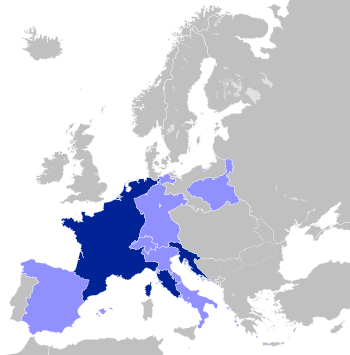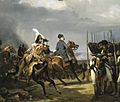First French Empire facts for kids
Quick facts for kids
French Empire
Empire Français
|
|
|---|---|
| 1804–1814 1815 |
|
|
Anthem: Chant du Départ
"Song of the Departure" |
|

The First French Empire at its greatest extent in 1812.
|
|
| Capital | Paris |
| Common languages | French |
| Religion | Roman Catholicism |
| Government | Monarchy |
| Emperor | |
|
• 1804–1814/1815
|
Napoleon I |
|
• 1815
|
Napoleon II |
| Legislature | Parliament |
| Senate | |
| Corps législatif | |
| Historical era | Napoleonic Wars |
|
• Constitution adopted
|
18 May 1804 |
|
• Coronation of Napoleon I
|
2 December 1804 |
| 7 July 1807 | |
| 24 June 1812 | |
|
• Treaty of Fontainebleau
|
11 April 1814 |
| 20 March – 7 July 1815 | |
| Area | |
| 1812 | 2,100,000 km2 (810,000 sq mi) |
| Population | |
|
• 1812
|
44000000 |
| Currency | French Franc |
| ISO 3166 code | FR |
| Today part of | |
The First French Empire, also called the Napoleonic Empire, was a powerful country in Europe. It was led by Napoleon I of France. This empire was very important in the early 1800s.
Napoleon became the Emperor of the French on May 18, 1804. He was officially crowned Emperor on December 2, 1804. This event marked the end of the French Consulate period.
Contents
Napoleon's Rise to Power
Napoleon quickly gained military victories. He won against countries like Austria, Prussia, Russia, and Portugal. These battles were part of the War of the Third Coalition. A peace agreement called the Treaty of Tilsit was signed in July 1807. This treaty brought an end to two years of fighting in Europe.
Growth of the Empire
The wars that followed are known as the Napoleonic Wars. These wars helped France expand its control across Western Europe and into Poland.
At its largest in 1812, the French Empire was huge. It had 130 areas called départements. About 44 million people lived under its rule. France also had large armies in Germany, Italy, Spain, and the Duchy of Warsaw.
Changes Under Napoleon
Napoleon brought many changes to the lands he controlled. He introduced the Napoleonic Code. This set of laws made things more fair for everyone. It also created jury systems and allowed for divorce.
Napoleon often placed his family members on the thrones of other European countries. He also gave out many noble titles. However, most of these titles disappeared when his empire ended.
End of the Empire
Napoleon gave up his power on April 11, 1814. The Empire returned briefly during a period called the Hundred Days in 1815. But Napoleon was defeated at the Battle of Waterloo.
After his final defeat, the Bourbon Restoration began. This brought back the monarchy of the House of Bourbon. Louis XVIII of France became the new ruler of France.
Images for kids
-
Napoleon I on his Imperial Throne by Jean-Auguste-Dominique Ingres, 1806
-
The Battle of Austerlitz, 2nd December 1805, by François Gérard
-
The Arc de Triomphe, ordered by Napoleon in honour of the Grande Armée, is one of several landmarks whose construction was started in Paris during the First French Empire.
-
Napoleon reviewing the Imperial Guard before the Battle of Jena, 1806
-
Aftermath of the Battle of Eylau, 1807
-
Napoleon demanded that Alexander I of Russia and Frederick William III of Prussia meet him at Tilsit in July 1807.
-
Napoleon and his staff during the War of the Sixth Coalition, by Jean-Louis-Ernest Meissonier
-
The Napoleonic Code
-
Map of the First French Empire in 1812, divided into 130 départements, with the kingdoms of Spain, Portugal, Italy and Naples, and the Confederation of the Rhine and Illyria and Dalmatia
-
Europe in 1812, with the French Empire at its peak before the Russian Campaign
See also
 In Spanish: Primer Imperio francés para niños
In Spanish: Primer Imperio francés para niños














